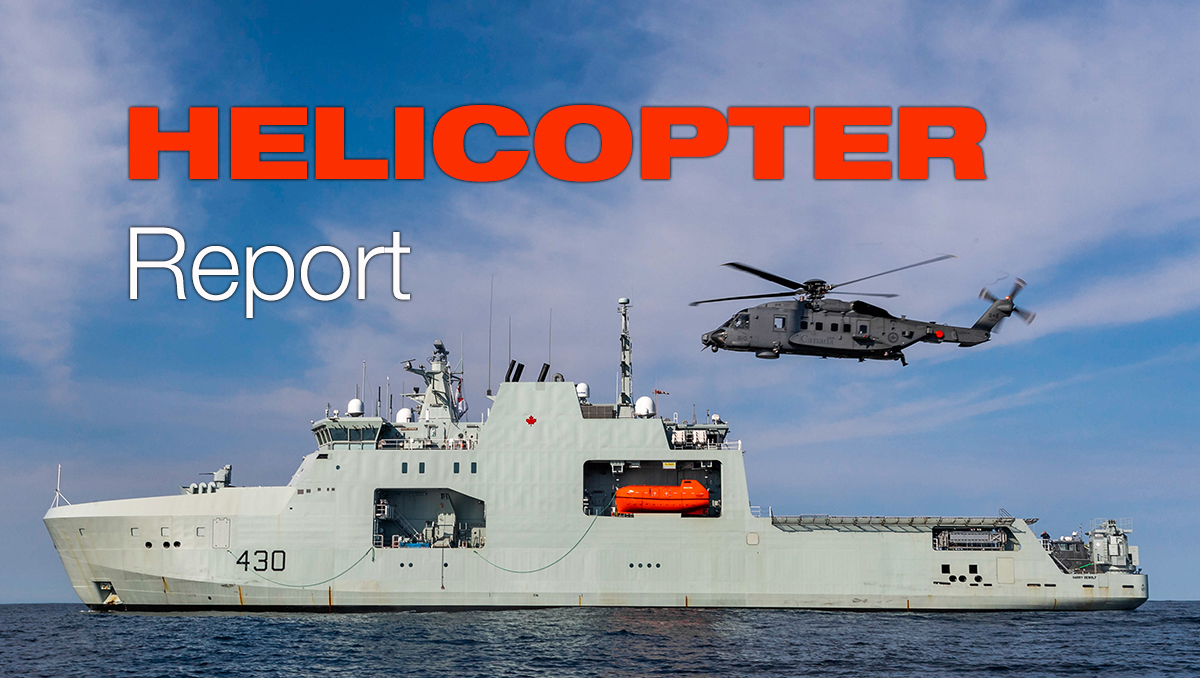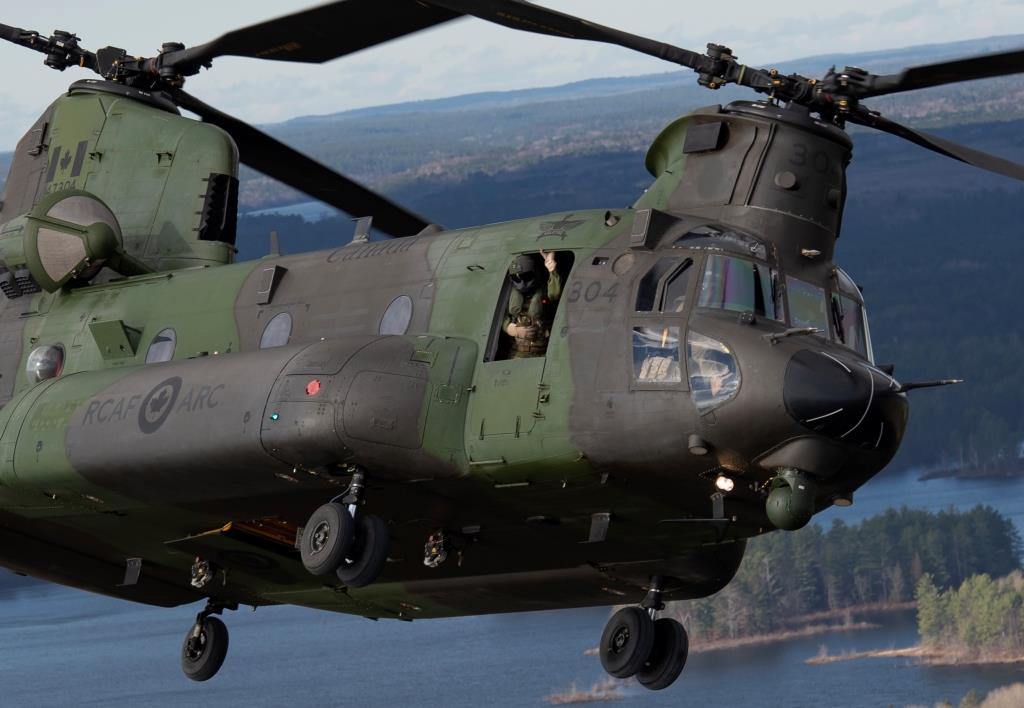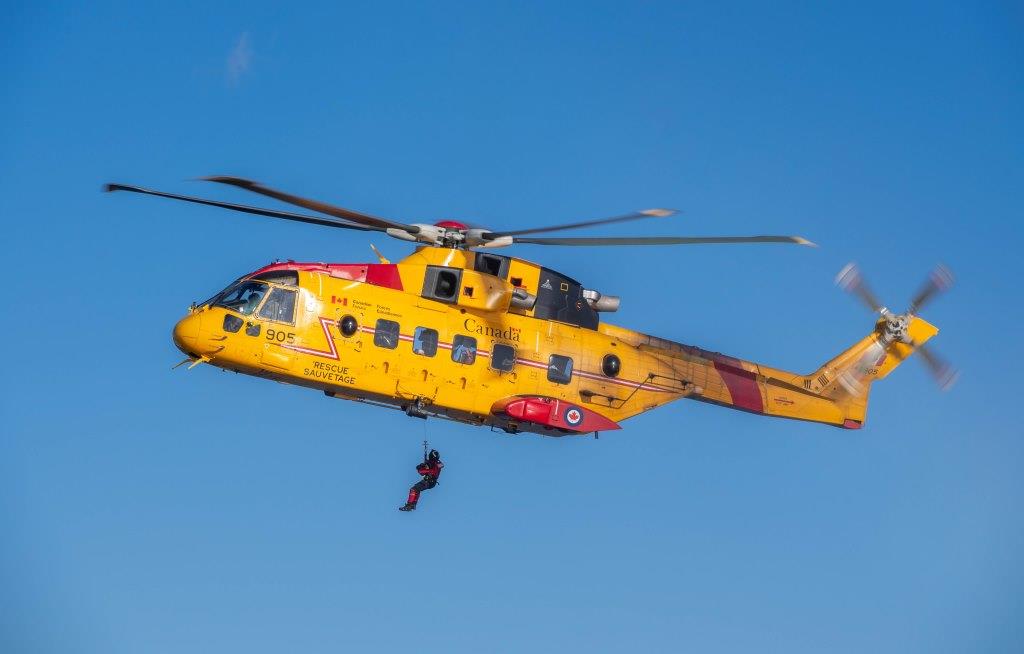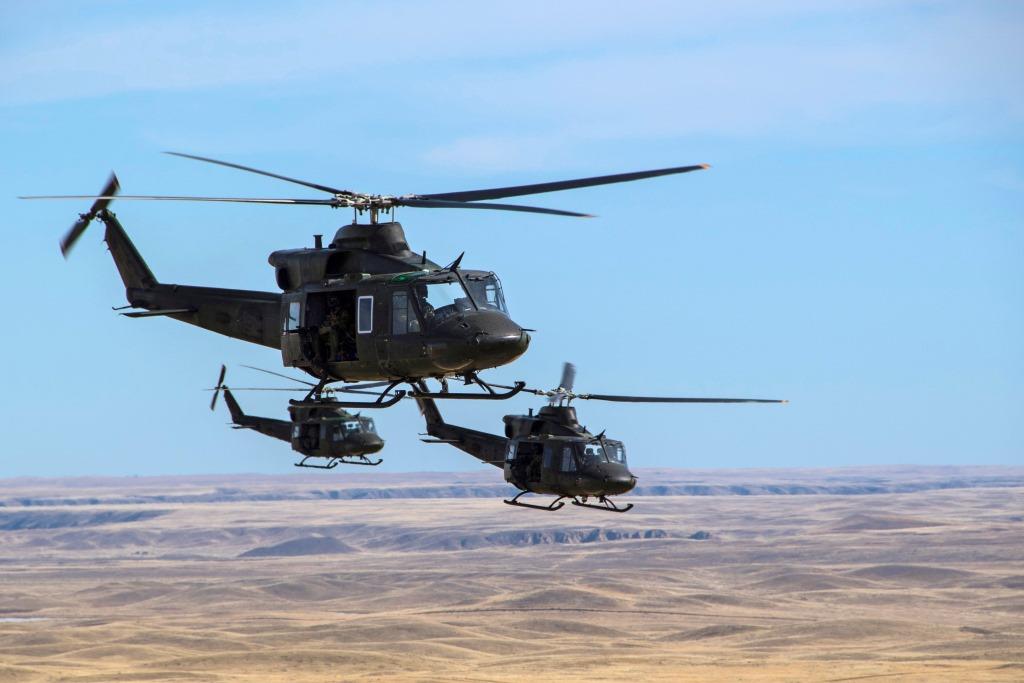HELICOPTER REPORT
BY JOETEY ATTARIWALA
RCAF TO UTILIZE ROTARY ASSETS
FOR PANDEMIC RESPONSE
For CDR’s annual report on helicopters in the CAF, we asked Aviation Editor, Joetey Attariwala, to talk to the appropriate Wing Commanders for first-person updates on the current status of these platforms.
Here is our in-depth report.
 At this point in time the Royal Canadian Air Force’s fleet of helicopters is a mix of new aircraft and platforms that are soon to be modernized, so for this report we wanted to talk to RCAF leadership about the operational status of those particular aircraft.
At this point in time the Royal Canadian Air Force’s fleet of helicopters is a mix of new aircraft and platforms that are soon to be modernized, so for this report we wanted to talk to RCAF leadership about the operational status of those particular aircraft.
The RCAF currently operates four helicopters: the CH-146 Griffon manufactured by Bell Helicopters; the CH-147F Chinook manufactured by Boeing; the CH-148 Cyclone manufactured by Sikorsky; and the CH-149 Cormorant which is manufactured by Leonardo.
In addition, Allied Wings has responsibility for the helicopters which it operates under the CFTS (Contracted Flying Training and Support) program at the Southport Aerospace Centre (SAC) in Manitoba. The helicopters operated there include the Bell 206 Jet Ranger and Bell 412CF Outlaw.
The RCAF’s tactical aviation wing is headquartered at 1 Wing at CFB Kingston where it is equipped with fleets of Griffon and Chinook helicopters. 1 Wing provides integrated tactical aviation airpower effects for the Canadian Army, CANSOFCOM (Canadian Special Operations Forces Command), and the RCAF as part of Canada’s national and international objectives.
Colonel Chris McKenna commands 1 Wing which has authority over the Griffon and Chinook fleets. He told CDR, “It’s a very interesting time for us because we’ve been so busy over the past five years if you think of successive deployments into Mali, and then overlay the multiple Iraq deployments that we’ve had since 2015 with both conventional and special operations aircraft.”
He added, “Our busiest period was the summer of 2018 to the fall of 2019 where we essentially had three tactical aviation detachments of Griffons and one detachment of Chinooks deployed out in perpetuity and in 3 separate and very distant locations, in addition to meeting our domestic mandates. That is a higher level of forward deployed tactical aviation than we had deployed during the war in Afghanistan, for that fifteen-month period.”
But what is the primary focus of those tactical fleets currently? McKenna explained, “One of the things we were anticipating in the summer of 2020 was the possibility of additional tactical aviation resources required for the enduring pandemic response and to determine if we were going to be needed to return once again to Iraq to continue to support the NATO Mission in Iraq [NMI]. We had a detachment that we validated and they were ready to go back into NMI, but it was covered off in the end by another NATO partner.”
McKenna continued, “That gave space for us to focus on our crew force, which was very tired as a result of all of these deployments, so it allowed us to re-focus on our own force generation and readiness. It also allowed us to focus on the realities of force generation during COVID, and to re-posture both fleets so we’ll be ready to go when next called by Canadians.”
PROTECTING AIRCREWS IN COVID ENVIRONMENT
A recent addition for both the Griffon and Chinook fleets is the integration of a Portable Helicopter Oxygen Delivery System (PHODS). “One of the things we’ve been concerned about is protecting the aircrew in the COVID environment, so this system, normally used for high altitude work with on board oxygen systems, attaches to an aircrew member’s HGU-56 helmet where it can provide similar protection to either a non-medical mask or an N95 mask, with integrated communications, depending on which kind of filter is fitted to the respirator. These are being fielded now,” McKenna revealed.
The CH-146 Griffon utility tactical-transport helicopter supports the tactical transportation of troops and materiel and performs search and rescue operations, surveillance and reconnaissance, training, casualty evacuations and counter-drug operations. The Griffon features GPS-satellite navigation and Doppler-radar systems and it can also be fitted with a variety of equipment, including self-defence weapons, a powerful searchlight, and a hoist to extract people and cargo from almost any terrain.
The RCAF currently operates a total of 85 Griffons (2 are maintenance trainers and not flying). Overall, the fleet is divided into four distinct groups: tactical/utility; special operations; search and rescue (424 Squadron); and combat service support (417, 439, 444 Squadrons).
As noted above, the Griffon fleet has seen extensive duty in Afghanistan, Iraq and Mali, and is now facing issues regarding obsolescence and compliance. The Griffon Limited Life Extension (GLLE) project will extend the life of the RCAF’s fleet of helicopters to at least 2031 by replacing a number of the aircraft’s avionics systems (including communications radios and cryptographic equipment, cockpit voice and flight recorders, navigation systems, automatic flight control systems, and control display units), upgrading the cockpit display, upgrading engines, and integrating sensor systems.
GLLE TO EXTEND LIFE OF GRIFFON
The project also includes upgrading the flight simulation and training devices as a result of the modifications, and the provision of equipment and spare parts. According to DND, the upgrade to the flight simulation devices will be procured under a separate contract.
The GLLE project entered the definition phase in January 2019. During this phase, the project team has been working with the aircraft’s original manufacturer - Bell Textron Canada Limited (BTCL) - to design and select the configuration of new systems to be integrated into the fleet during the implementation phase. The definition work will be performed under the current Optimized Weapons Systems Support (OWSS) contract, which was awarded to BTCL in 2011.
As part of the definition phase, a Letter of Interest was issued on 10 February 2020, to inform industry of its intent to carry out the implementation phase of the Griffon Helicopter life-extension project with BTCL acting as the lead integrator for the GLLE project. BTCL will manage a competitive process, with oversight by Public Services and Procurement Canada, to source qualified suppliers to install upgrades on the fleet of Griffon helicopters.
DND provided a written statement to CDR which addressed the sole source contract award. It reads as follows:
“As stated in Strong, Secure, Engaged, Canada’s defence policy, the Government of Canada is making investments to recapitalize or extend the life of existing capabilities in advance of the arrival of next generation platforms. As the owner of the intellectual property rights, BTCL was the only company certified to do the definition work, and capable of performing a full assessment of the design and certifying any design changes or associated repairs. BTCL – the original equipment manufacturer – will develop design changes to upgrade the helicopter’s avionics systems, engines and cockpit displays, and integrate sensor systems. During the next few years, the project team will work with the aircraft’s original manufacturer on design solutions for the required upgrades. Up to three prototypes will be used to test and gather feedback on draft designs. Once the final design has been tested, the project will move to the implementation phase which is anticipated to start in 2022. A separate contract is expected to be awarded for the implementation phase in 2022. The Government of Canada will be seeking industry participation when and where possible for this phase of the procurement.”
WORKING WITH BELL TEXTRON CANADA
The project expects to reach Initial Operational Capability by 2024 and complete implementation for all 85 CH-146 Griffons by 2027.
Colonel McKenna talked to CDR about the ramifications of GLLE, “As of 2025 we will no longer be able to operate the Griffon internationally or continentally in some cases unless we modernize some of the avionics systems. We also need to modernize the IFF [Identification Friend or Foe] system to Mode 5 in order to be able to operate in coalition airspace. GLLE will extend the aircraft by about ten years, so that brings us out to at least 2031.”
McKenna explained, “The program will give us a fully integrated digital cockpit which will have military grade components linked to the tactical mission set. That means it will digitally integrate key stems like the radar / laser warning receiver, EO/IR, missile approach warning receivers, the countermeasure dispensing system - all of that has to be integrated into this upgraded digital cockpit and hardened for security. GLLE will also provide for the re-engining of the entire fleet, so each aircraft will have new twin-pack engines with Full Authority Digital Engine Control.”
He added, “Another new capability will be a 4-axis autopilot system which will introduce a heightened level of automation into the fleet and significantly assist with Degraded Visual Environment approaches and provide for a stabilized coupled hover capability in the Griffon Mk 2 that the legacy Griffon did not have.”
The first Griffon will be delivered to BTCL in March 2021 for the first developmental install of the GLLE capability.
BOEING SUPPORTS CH-147F CHINOOK

The RCAF has a fleet of fifteen CH-147F Chinook aircraft, an advanced, multi-mission helicopter which is used to transport equipment and personnel during domestic or deployed operations. The Chinooks support the Canadian Army, special operations forces, other government departments, law enforcement agencies and civil authorities. These aircraft have enhanced self-protection capabilities, including anti-missile protection systems, radar as well as laser warning systems, ballistic protection and self-defence machine guns. ISS for the Chinook fleet is being provided by The Boeing Company which was awarded a 20-year support contract.
RCAF Chinooks have approximately 30 modifications and adaptations when compared to a baseline U.S. Army CH-47F Chinook. Many of these modifications were incorporated because of the unique conditions and operating environments found in Canada.
“We invested heavily in a self-protection suite which is a lot of what the modifications are linked to. We also spent time to get the cockpit aligned to our expectations for automation and how we operate our helicopters in the RCAF. The software is largely the same as for the US Army F Models using the Rockwell Collins Common Avionics Architecture system with some minor tweaks to CAAS page orientation, depth and logic.”, said McKenna.
He explained, “We kept our CH-147F CAAS software very close to what the U.S. Army has fielded, but we had the ability to change some aspects based on our own lessons learned in the RCAF and some of the things that we’ve mandated in other helicopter fleets linked to our experience with automation and human factors, as well as how the aircraft would be employed in the RCAF. Another difference from a standard U.S. Army Foxtrot is we have an updated Auxiliary Power Unit generator and we upgraded the main electrical generators on both engines. That was done to feed power to all the systems and to the advanced countermeasure system that we have installed on our Chinooks.”
And McKenna talked about how Canada’s Chinook was set up for this country’s particular needs, “We were also the first international Foxtrot Chinook customer to have ‘fat tank’ Chinooks and that’s really an acknowledgement of Canada’s context of needing to operate in the Arctic and the long endurance missions we are often called upon to execute in Canada’s North. That additional fuel capacity really paid off for us in Mali as well, given the austerity and distance between fuel stops in the Sahel. Another feature that we have on the RCAF Chinook which is somewhat unique is a power-down rear ramp - it was installed so that we can push it down through deep snow if needed to enable cargo and passenger loading in the Canadian operational environment.”
DEPLOYING TO ALASKA FOR ARCTIC TRAINING
Although COVID restrictions pose considerable operational challenges, 1 Wing is currently planning to deploy a detachment of Chinooks to Alaska in February for Arctic training with the U.S. Army. Speaking to this McKenna said, “We’re still working out all the details of Canadian and U.S. state and federal regulations that we need to abide by. We have a number of tools at our disposal for COVID risk assessment, and we would have to put a quarantine and operational testing protocol in place in advance of deploying that team across the border or into the field to train together. The detachment we are proposing for Alaska is scalable from two to four aircraft. Planning for the viability of this deployment continues with a final assessment planned for January 2021 based on the COVID-19 climate at that time”
One of the next capabilities for the Chinook which is working its way through the procurement system is the Extended Range Fuel System (ERFS) with the Forward Area Refueling Equipment (FARE) kit. “It’s a plug and play capability which in essence allows you to add large palletized cubes of additional fuel as cargo inside the Chinook,” said McKenna. “The aircraft is already plumbed for it and the cockpit is ready to accept the system once it’s plugged in. Our Chinooks can carry 13,600 pounds of fuel internally, which translates into approximately five and a half hours of endurance. Each fuel pod adds 5,000 pounds of gas so that would give an additional 2 hours of endurance. Another big advantage to this system is it would enable us to give gas to other aircraft like Griffons, or to Canadian Army, allied army, or SOF vehicles. From my point of view, this would be a transformational capability increase for the Chinook and for Tactical Aviation, especially with a view to the Arctic operating environment.”

ONE LESS CH-148 CYCLONE IN THE FLEET
DND, through MHP (the Maritime Helicopter Project), is acquiring a fleet of 28 CH-148 Cyclone helicopters along with associated logistical and in-service support.
Sadly, the RCAF suffered a tragedy on 29 April when a Cyclone bearing the callsign STALKER 22 crashed in the Ionian Sea, killing all aboard. Following the accident, the Commander of 1 Canadian Air Division implemented an operational pause on the CH-148 Cyclone fleet as a precaution while the RCAF’s Directorate of Flight safety investigated the accident. The investigative team was able to replicate the conditions that lead to the accident in the CH-148 simulator, and confirmed that it occurred under a very specific and narrow set of circumstances.
In June, following a thorough risk analysis process, specific mitigation measures were established that allowed the fleet to safely return to operations. These measures include updates to training (ground and simulator training) and aircraft publications to make aircrew more aware of the possible risk identified by the Flight Safety investigation and how to avoid it during flying operations. They also include changes in operational maneuvering of the aircraft to further reduce risk, while not affecting the Cyclone’s ability to effectively conduct operations at sea. These measures are still in place and will remain so for the foreseeable future.
Since then, the Cyclone has continued operations with two of the type participating for the first time at the Rim of the Pacific exercise. Cyclone Helicopter Air Detachments continue apace, with one detachment currently aboard HMCS Winnipeg in the Western Pacific, and another detachment embarked aboard HMCS Toronto.
To date, 16 Cyclones have been delivered to Canada, or upgraded to the Block 2 configuration. Delivery of the last helicopter in the Block 2 configuration is scheduled for the end of 2021.
The “blocking strategy” is a phased approach to introduce capabilities over time. The Block 1 configuration was used for training and operational testing of multiple capabilities including search and rescue, utility transport, and surface and sub-surface surveillance roles. The Block 2 configuration introduces improvements to the helicopter’s mission system. Some of the most notable differences include improvements to the helicopter’s sonar and radar capabilities.
The final contractual upgrade from the original acquisition contract is known as Capability Release 2.1 which provides modern, tactile mission system displays, and upgrades the mission computer, radar functionality and mission system software. Taken together, the changes will improve the tactical and sensor operators’ situational awareness and efficiency. This capability will be introduced in the form of an in-service modification where Sikorsky will deliver modification kits starting in January 2021. RCAF technicians will then install the modification kits on the fleet over a 12 to 18-month period.
CYCLONE TO OPERATE OFF AOPS SHIP
Colonel James Hawthorne, is Commander of 12 Wing and he spoke to CDR about operational plans for the Cyclone, “Transitioning to the Cyclone and learning all the minutia is taking time, but we will get there, and we’re very happy to get the helicopter on ships because that’s where we learn how to effectively employ and maintain the Cyclone at sea. This year we've had four detachments deployed at the same time, and next year we plan to have five detachments simultaneously at sea. We are also working on a plan to conduct Cyclone Ship-Helicopter Operational Limits with the new AOPS. 12 Wing is expanding the envelope every day, and it’s going to get much better once we have all 27 Cyclones by the end of next year.”
The RCAF currently operates a fleet of 14 CH-149 Cormorant search and rescue aircraft. The aircraft have now been operating for 20 years and are in need of a mid-life modernization, dubbed the Cormorant Mid-Life Upgrade (CMLU) project.
The CMLU project is intended to extend the estimated life expectancy of the Cormorant to at least 2042, address obsolescence issues, ensure compliance with emerging regulations, and address a search and rescue capability deficiency at the Trenton Main Operating Base. The CMLU solution will in part utilize some of the VH-71 Kestrel aircraft that Canada acquired from the United States. This will increase the fleet to 16 aircraft, and will enable the Cormorant to return to CFB Trenton.
While the CMLU project is still in the project definition phase, the Government has been working with the aircraft’s original manufacturer, Leonardo, to identify how these updates and upgrades could be made.
CELL PHONE DETECTION SYSTEM A GAME CHANGER
Colonel Dany Poitras, is Commander of 19 Wing and for this report he talked to CDR about the Cormorant, “The upgrade is intended to bring a state-of-the-art avionics system which will be integrated with radar and electro-optical sensors. The upgrade will also deliver a Helicopter Terrain Avoidance System, an upgrade to the Automatic Identification System, and a cell phone detection system. Similar to the GLLE program, these upgrades will ensure we are compliant with changes in regulations. It is important to note that what is in the scope of CMLU might not be what’s delivered in the end based on pricing and so on, so it’s hard to speak about specifics as we’re negotiating with Leonardo right now.”
The scope of the CMLU project also has within it the provision for a Full Flight Simulator which, if realized, would allow Cormorant pilots to train here in Canada as opposed to England.
The CMLU project will be implemented in the coming years, but in the meantime the Air Force is seeking a Cellular Airborne Sensor for Search and Rescue. Poitras explained, “This will be in the form of a stand-alone kit which we will put on all the primary search and rescue aircraft, including fixed wing aircraft like the Hercules, Buffalo, and the incoming Kingfisher. The system will function like a cellular tower and will allow us to track a cell phone for search and rescue purposes. This project will be implemented by the end of this fiscal year, and I feel will be a game changer for search and rescue.”
Under the Cormorant Repair and Overhaul Support Service (CROSS+) contract, Leonardo MW Limited has agreed to an extension of the In-Service Support for the Cormorant fleet until 31 July 2021, with IMP Aerospace. This will ensure the sustained repair and overhaul of helicopter components as well as engineering support and spares.
Joetey Attariwala is CDR’s Senior Staff Writer and Aviation Editor


